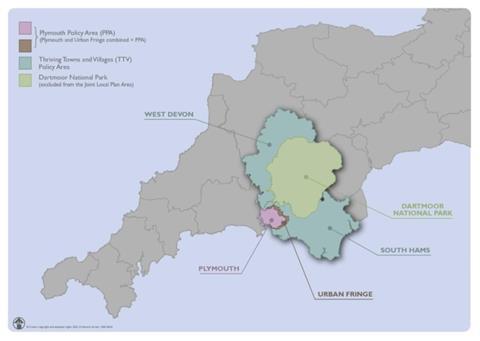Time and again hold-ups in the planning system due to council resourcing problems are cited by housebuilders as a major barrier to development. In a special long-read, Emily Twinch talks to planners about what is really happening on the ground – and what is needed to fix the problem.
“Demoralising”, “miserable”, “depressing”. This is how officers anonymously described working in planning departments to a podcast called 50 Shades of Planning recently. There has been a resources issue in local authority planning departments for some time, but the problem now appears worse than ever.
Stretched funds and low numbers of staff are the major contributing factor to delays in the system. Last year a RIBA future trends survey showed nearly eight in 10 architecture practices reported projects being put back because they were getting stuck in the planning system.
Savills has a non-exhaustive list of 14 authorities that have delayed or halted their local plans. This is because of policy uncertainty with the levelling up and regeneration bill on the horizon, but is also in many cases also due to a lack of resources.
The people doing the work are feeling the strain. “It’s really demoralising and morale is at an all-time low,” says one officer to the podcast. Another officer explains: “The last 24 months have been miserable.” A third adds: “The lack of leadership and competent management is a real issue, and it makes the rest of the team underneath feel depressed.”
These problems in the planning system are a massive barrier to increasing new home delivery and risk severely hampering the government’s previously stated goal of ensuring that 300,000 new homes are built in England every year.
With pressures on local government, funds are often diverted from planning departments to areas such as social care and education, which are seen as greater priorities. Back in March this year it was revealed that planners in Slough had been forced to halt their local plan because the budget for it had been “taken away”.
Analysis of government figures from the Royal Town Planning Institute show that English local authorities reduced net investment in planning over eight years by 42% from 2009/10 to £400m by 2017/18. Although government figures show local government net spending on planning and development services went up from £1.383bn in 2019/20 to £1.915bn in 2020/21, demand on planning departments remains high and that increase in funds looks unlikely to make up for that cut over eight years.
So how did planning get into this state and what, if any, are the solutions?
Home improvements

One of the reasons for the surge in applications recently has been because during the pandemic home owners took the opportunity to finally get that extension done.
Rebecca Coley, head of planning and development at Trafford council, who heads up a department of 30 planners, says: “We are reasonably well resourced and in 2019 we were able to deal with the volume of applications that came into us.” But she said that, following a two-month respite at the start of the pandemic, the applications for people wanting to do home improvements rose. Her department is now getting roughly 20% more applications a month it was than before the pandemic.
Coley estimates this was enough work to require four more officers - but her department had to manage with the staff it already had. This surge in applications has led to increased workloads and low morale for officers, as frustration grows about more time taken to process smaller applications.
What we are finding is we have had a lot of turnover at the lower levels
Rebecca Coley, Trafford Council
“Staff dealing with home extensions haven’t had the easiest time,” Coley explains. This is a similar picture across the country. Councils have reported officers at home being shouted at because home extension applications have not been dealt with quickly enough.
One officer tells the 50 Shades of Planning podcast: “Our current situation is that we’ve done more work than ever for the same pay, no thank-yous - just abuse for not getting decisions out fast enough.”
Another points out: “Furlough was the killer for us. People had more time to chase their applications, so we were taking back-to-back calls of people asking ‘what’s happening’.”
Alex Yendole, strategic planning & placemaking manager at Stafford Borough Council, also highlights that it can be challenging working from home “because of trying to view large-scale maps and making decisions using large-scale plans”. These pressures have meant people have quit their jobs in council planning departments leaving even fewer officers to do the work. “What we are finding is we have had a lot of turnover at the lower levels,” says Coley.
Skills drain
RTPI research from April 2020 shows that, even at the start of the pandemic, one in 10 roles in planning in England were unfilled. Many times when planners leave councils it is to work in the private sector.
Paul Seddon, director of planning & regeneration at Nottingham council, says it is a “competitive market” in which to hire planners. “I think both graduates and experienced planners can almost pick and choose where they want to work.”
He explains that there are some “aggressive” planning consultancies that “do actively have conversations with good planners working in local government”, with a view to poaching them.
Yendole adds: “There’s quite a number of experienced planners, practitioners who then retire or work part-time or set up consultancies. Then those skills are either lost or reduced.”
He suggests: “Support is needed to encourage the younger generation to be interested and passionate about housing delivery and planning. There’s work to be done with schools and universities to make sure that the cohort of graduates continues to grow rather than decline.”
The RTPI has been working to combat the planning skills drain. One example is the level 7 chartered town planner degree apprenticeship scheme, run through RTPI accredited planning schools at 11 universities in England and funded by the government.
>> Also read: Whatever happened to those radical planning reforms?
There are believed to be 448 students on these degree apprenticeships. But Seddon says what is needed is for the government to get behind that work and promote it. “The government messaging around planning has not been an enticing one,” he adds.
People don’t know what planners do. We need to showcase what it is like so people can understand how the work of planners impacts their lives
Paul Seddon, Nottingham Council
Central government has been painting planning as a problem for housing delivery, Seddon suggests, and instead it needs to “hugely amplify” work that organisations such as the RTPI are doing. Seddon also says there needs to be a concerted effort across authorities to improve the reputation of planners.
Richard Blythe, head of policy practice and research at the RTPI, agrees. “People don’t know what planners do. We need to showcase what it is like so people can understand how the work of planners impacts their lives,” he says.
There will also be a need for planners with more specific skill-sets in the future, such as in the area of biodiversity. Through the 2021 Environment Act it is expected that, from November next year, schemes will have to add 10% in biodiversity gains to sites compared to pre-development.
David Renard, housing spokesperson for the Local Government Association, said: “In order to achieve biodiversity net gain through the planning system, access to ecological experts is essential and something that many planning teams do not currently have.”
Yendole says this is a “big area of work … It’s absolutely crucial to make sure we’ve got the skills and capacity in the future.”
Fees and funding

But how can councils fund increased skill and boost capacity with such a shortage of resources?
When contacted for comment the Department for Levelling Up, Housing And Communities said: “We recognise the importance of having efficient and effective planning departments, capable of providing a planning service that local people expect.
“That’s why at the last spending review we announced an additional £65m to invest in the planning system and support the sector with the skills and capability required to deliver places people can be proud of, and have the skills needed for successful delivery of changes to the planning system.”
That £65m, announced in the Budget last year, was money for improving planning through digitalisation.
Blythe reminds us that council finances across the board have been stretched since austerity in 2010 and, while departments did get government grants for projects such as local plan-making, that had now “dried up”. Seddon, who says he hasn’t noticed any of the £65m coming to his department, says that while there have been “various grants over the years” for delivery or improvement work, they are “not really long-term funding streams”.
He said it was “counter-productive” to have local government “compete among itself”, such as for pots of regeneration money. “That competitive nature – I don’t think is the most effective way of doing things.”
A proposed increase in planning fees will help to build capacity, but this increase on its own will not be enough to comprehensively address the issue of resourcing
David Renard, housing spokesperson LGA
“The problem is a larger proportion of running a planning department has to fall on the shoulders of the planning fees,” Blythe says.
The government has said, as part of the levelling up and regeneration bill, that it will increase planning fees for major and minor applications by 35% and 25% respectively. This is expected to come into effect in 2024.
But Renard says: “A proposed increase in planning fees will help to build capacity, but this increase on its own will not be enough to comprehensively address the issue of resourcing in the planning sector; and government can go further by allowing councils to set planning fees locally.”
Thinking innovatively
The LGA has been lobbying the government to allow planning fees to be set locally. Seddon believes there should be more of a long-term solution for funding councils. Any money for planning coming from central government should be ring-fenced, he suggests.
The government, which controls planning fees, could have a five-year plan to increase the rate, the Nottingham council planning director says. Rather than the government raising it randomly. “A five-year position on fees would work.”
Seddon thinks fees could, for example, rise by the rate of inflation every 12 months in a five-year plan. This could help remove some of the uncertainty that planning departments have about the money they will have coming in.
Local authority hands are tied as to what they can pay planners within the council grading pay system, unlike in the private sector, but they can find other ways to incentivise recruitment and retention.
Case study: is joined-up working between councils a solution?

Plymouth City, South Hams District and West Devon Borough councils came together to start work on a local plan in 2016. Their joint local plan for up to 2034 was adopted in 2019 and the team continues to work together for strategic planning.
The team is considered a success and is now preparing for the changes that are likely to be brought in by the levelling up and regeneration bill and will be reviewing the local plan. The team of five, although based in their own councils, often come and meet together to work.
Two members of the team are from Plymouth City Council, two from South Hams and West Devon and Joanna Lee, who manages the team as strategic planning manager (joint local plan), is also from Plymouth.
She explains: “South Hams and West Devon don’t have the resources that Plymouth has. Together we can work more efficiently and get better results.”
As well as being able to share funding and skills, Lee said the relationship between the councils has improved and, as a result, they are more effectively planning for the urban fringe. Joint working also provided “greater resilience” by increasing capacity and sharing skills.
She said the team would keep going, so long as there was political will to do so. “We’ve got good governance arrangements,” Lee said. “I don’t think there’s any indication we will stop it in the foreseeable future.”
Yendole says it is important that councils ensure officers are trained and skilled as well as resourced. “With experienced officers passing on knowledge,” he says. The RTPI is looking at what local authorities can do to improve the employee experience.
“One of the possibilities is to try to treat people in the public sector as if they are in the private sector,” Blythe says.
He explains one of the issues is that there is no obvious career progression in public sector planning. Coley adds: “We can’t offer the pay and conditions of the private sector.”
She says councils need to “think innovatively”. She says her department tries to promote internally “so people feel there is the same career progression you get in the private sector”.
Coley also tries to “keep the passion and enthusiasm for planning and bring people with me”. She tries to organise work events where people can also have some fun and socialise.
The government has said: “We want to ensure that councils are well-resourced and that planning professionals have the right skills to make creative decisions and take forward ambitious proposals.”
Perhaps the government needs to put its money where its mouth is - and ring-fence any cash that it gives. This, plus talking up the planning profession so that people are not discouraged from entering it, might have an impact. Because if it does not, housebuilding is likely to be impacted.
After all, as Samuel Stafford, planning director at the Home Builders Federation, who runs the 50 Shades of Planning podcast says, getting the planning system right is “in everyone’s interests”.
A Fair Deal for Housing

���ܾ����徱�Բ�’s sister title Housing Today believes the government should not back away from its manifesto pledge of building 300,000 new homes a year by the middle of the decade. We badly need more homes, and a lack of supply is a major factor in creating problems of affordability for both buyers and renters.
Over the next few months, Housing Today will be exploring potential solutions to help us ramp up housebuilding to 300,000. These are likely to include different ways of working, funding asks of government and policy ideas that could boost housebuilding.
We want to hear from you: what do you think can make a difference at a policy level?
What can the industry do better?
We believe that, with the right commitments from ministers and the industry, it is possible to build more homes and help the government to meet its objectives to “build beautiful”, improve quality and safety, boost home ownership and level up the UK.


























1 Readers' comment